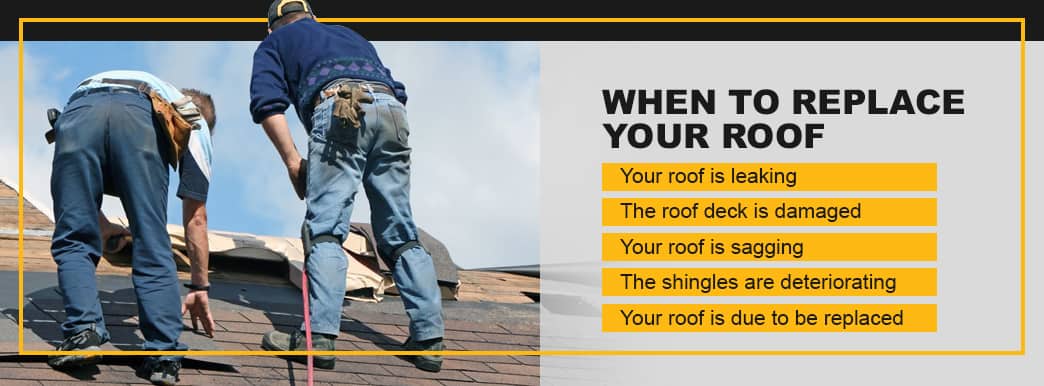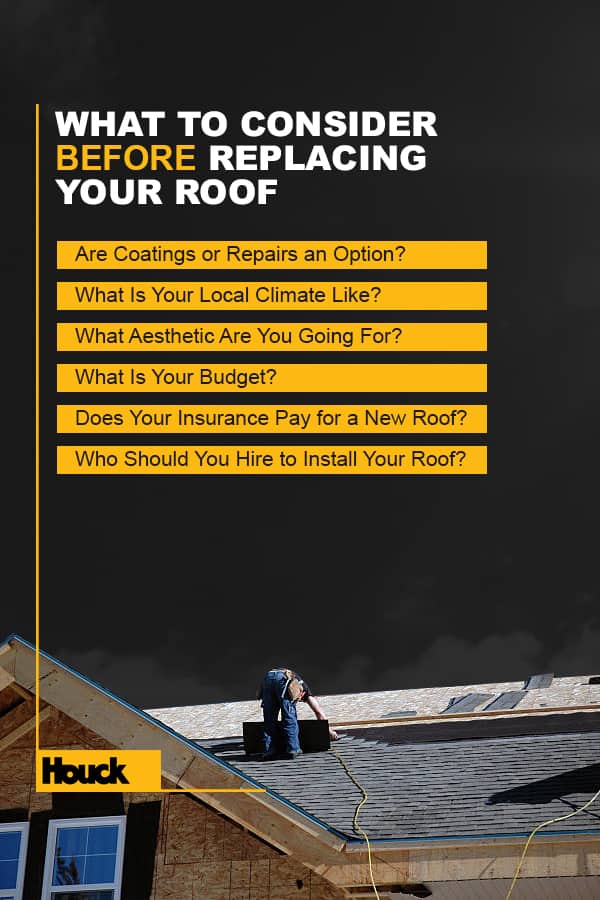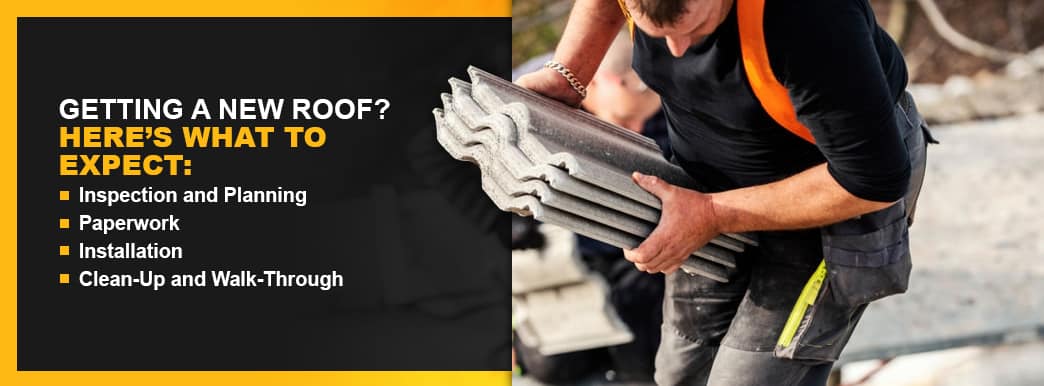Roof Replacement: What You Need to Know
Everything You Should Know About Roof Replacements

When to Replace Your Roof

- Your roof is leaking: One sign you may need a new roof is if your current one is leaking. You may notice leaks when water drips down through your ceiling or when your building starts to develop a musty smell. You may be able to repair leaks, but if your roof is springing leaks because it’s aging, you may need to replace it.
- The roof deck is damaged: When you think about the condition of your roof, you likely focus on what you can see, but the parts of your roof you can’t see are just as critical. Since decking is made from wood, it’s subject to issues like water damage and rot that can call for a roof replacement.
- Your roof is sagging: If your roof is sagging, this is a sure sign that something is wrong. One possibility is that your roof joists are too small or too weak to stand up to the weight of snow and ice that settles on the roof at times. A sagging roof is, at least, cause for repairs and may indicate it’s time to install a new roof.
- The shingles are deteriorating: If you have an asphalt shingle roof, you can usually tell it’s time to replace the roof when shingles are starting to crumble and deteriorate. This may lead to granules in your gutters. You may also notice dark streaks forming on shingles, which is a type of algae that tends to form with age.
- Your roof is due to be replaced: Finally, if your roofing material has reached the end of its lifespan, then you should consider replacing your roof. Any roofing material may be able to outlive its predicted lifespan with careful maintenance, but especially when it comes to cheaper materials like shingles, you should expect to replace your roof after two decades or less.
What to Consider Before Replacing Your Roof
Are Coatings or Repairs an Option?
What Is Your Local Climate Like?
What Aesthetic Are You Going For?
Aesthetic tends to be more of a concern for homeowners replacing their home’s roof, but it should also be a concern for industrial and commercial property owners and managers, as well. Your chief concern may be functionality, but that doesn’t mean you need to ignore appearance. The best roofing system is one that protects your building and enhances the building’s overall aesthetic.
Consider the architectural style of your building and any colors you would like to feature or match. Some roofing types, such as built-up roofing, aren’t visible to people below and won’t afford much room for customization, but many other types of commercial roofing materials, such as rubber or metal, come in different colors and finishes. You may even want to set your building apart with a garden rooftop.
What Is Your Budget?
Another thing you’ll want to think through when you need to replace your roof is your budget. One way to think about your budget is to simply consider the amount you’re willing to spend and then choose an option that fits within that limit. Another approach that may serve you better in the long run, however, is to think of your new roof as an investment, the benefits of which you can continue to reap over time.
This may mean expanding your budget a bit to install a better quality roof. When you spend more now on a high-quality roofing system, you can save money in the long run since you likely won’t have to spend as much on repairs and will be able to wait much longer before replacing your roof again. Some roofing materials even have the potential to last a lifetime.
Does Your Insurance Pay for a New Roof?
When you’re considering your budget for a new roof, you should check your insurance policy to see if it will cover the cost of a new roof. Home insurance policies often include provisions for roof replacements in the case of acts of nature. Commercial policies may also include coverage for either repairing or replacing a roof that has been damaged by things like insects, fire and storms.
Typically, insurance companies will not offer any assistance with roofs that are ready to be replaced after experiencing normal wear and tear, so this responsibility will fall on the property owner. Every policy is different, so you should check yours to see whether a new roof or roofing repairs may be covered.
Who Should You Hire to Install Your Roof?
Finally, you’ll need to think through who you’re going to hire to install your new roof. It’s in your best interest to work with a company like Houck, who will apprise you of all your options and won’t try to pressure you into paying for a full roof replacement when you may only need repairs. An experienced and fair roofing company will be able to consult with you and provide valuable input to help you settle on the best roofing solution for your building.

Check online reviews and talk to colleagues and friends who have had their roofs replaced recently to get some recommendations. Keep in mind, however, that, if your roofing project calls for a special set of skills, such as historical restoration, you may not want to go with a company your neighbor used. Instead, look for a company that specializes in your type of project.
Getting a New Roof? Here’s What to Expect:
1. Inspection and Planning
The first week or more of the process will involve inspecting your current roof and making a plan. A craftsperson will take a close look at your current roof to determine whether replacing the roof is the best course of action and will then help you determine what type of roof to install. The roofing company should also provide you with a quote at this point to help you budget for your new roof.
2. Paperwork
Once you’ve planned your project, the next step is for your roofers to obtain the necessary permits. Most cities require building permits for roofing projects to make sure they abide by the relevant building codes. Another type of paperwork you should receive at this point is a written contract detailing the agreement between the roofing company and you. You should also ask for a written confirmation that your roofing company has the necessary insurance coverage for your project.
3. Installation
The installation itself will likely go much faster than the planning and paperwork leading up to it. Depending on the size and type of roof, installation may take several days. Your roofing craftspeople may have to start by removing the old roof, depending on how many layers of surface material you have, what condition it’s in and whether they need to get to the decking to make repairs. Depending on the project, you may have to vacate your building during the roof installation
4. Clean-Up and Walk-Through
After your roof is installed, your roofing craftspeople will spend a day or so cleaning up. This typically includes disposing of the previous roofing material that was removed and collecting any debris lying around. Your roofers may also use a magnet to collect any screws, nails or other metal pieces on the ground. All these materials will go into a dumpster that will be hauled away. Finally, you should be able to do a final walk-through with your roofer to see the results of the project.

Preparing Your Roof for Replacement
- Cut the grass: Keeping your grass short will help your roofers mind any pieces that are dropped on the ground, including small objects like nails, screws and staples.
- Cut back trees: If there are any tree branches that are encroaching on your roof, you’ll need to prune these back to keep them out of the way for re-roofing. It’s also wise to maintain space between trees and your roof, so they don’t damage your roof.
- Move outdoor objects: You should also move objects like potted plants, outdoor furniture, ceramic landscaping features and anything else that could break if it were to be hit by a falling piece of debris from the roof. If you have a satellite dish on your roof, you’ll need to move this, too.
- Move vehicles: You’ll want to leave a large path on your driveway or parking lot for your roofers to come and go with materials. Moving vehicles to the other side of the parking lot or down the street will also help protect them from falling debris.
- Identify outlets: One way you can help streamline the process is by identifying the most convenient outlets ahead of time for your roofers to access for power tools. Outdoor outlets are ideal. If you only have outlets inside your home, you’ll need to run an extension cord outside.
- Clear out the attic: Gaps in your decking can allow objects and debris to fall through during the re-roofing process, so if you have an attic, you’ll want to either remove the items you have stored there or cover them with a tarp to ensure nothing gets damaged.
- Remove wall hangings: You may also want to take down wall hangings, especially if you’re having work done on the roof decking and not just the surface material. This will prevent pictures from falling down and breaking due to vibrations and impact from above.
- Notify neighbors: It’s courteous to speak with neighbors, whether neighboring homeowners or neighboring businesses, ahead of time to let them know you’ll be having some work done. This small gesture can go a long way toward preventing a disturbance.
Houck Can Meet All of Your Roofing Needs
A roof replacement can be an involved process, but it’s sometimes a necessary step when your existing roof has come to the end of its lifespan. Keeping up with the health of your roof is critical, so you can ensure your roof continues to provide the insulation and protection your facility needs.

If you think your roof may need to be repaired, reinforced with a coating or replaced, you can trust Houck Construction in Central Pennsylvania for all your roofing needs. With over 70 years of experience, we can help answer any questions you may have about the industry or best roofing practices.
Contact Houck today to learn more about how we can help you enjoy the benefits of a top-quality roof.